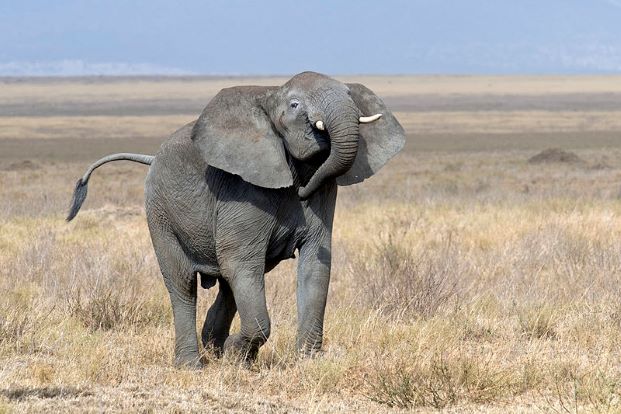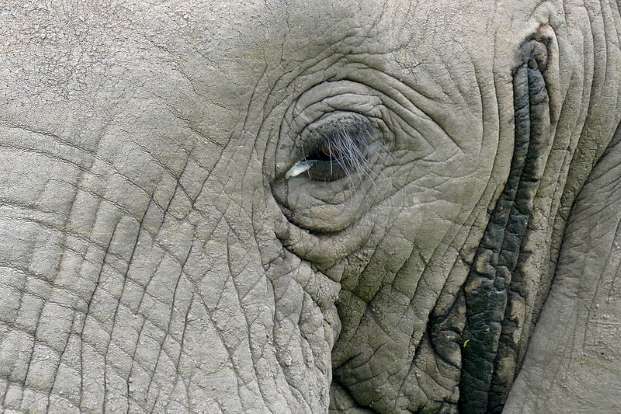Musth is a bological condition unique to bull elephants during which its testosterone levels rise dramatically. On average the rise in testosterone levels can be 60x greater than in the same elephant during normal times.
Telltale signs include the elephant walking with a swagger and oozing oily fluid from its temporal glands. Trails guide Rhodes Bezuidenhout of Shangani Trails provides a full overview of the condition.
- What is elephant musth?
- How often do elephants go into musth?
- How long does musth last?
- How can you tell if an elephant is in musth?
- Where does the word, musth, originate from?
- Do female elephants go into musth?
- How old are elephants when they first go into musth?
- Do any other animals go into musth?
- Will an elephant in musth be on its own?
- What is musth swagger? Opens a seperate post on Fascinating Africa
1. What is elephant musth?
Musth is a condition unique to elephant bulls which entails a dramatic rise in testosterone levels within the bull’s biological system. This results in a strong desire to mate. The higher levels of testosterone will also likely result in the bull becoming more aggressive with unpredictable behaviour often being observed.

2. How often do elephants go into musth?
Elephant bulls come into musth once a year with the condition happening at approximately the same time each year.
3. How long does musth last?
There is no certain time period associated with musth, the condition could last for up to 3 months while shorter periods in weeks or even days are also common.
4. How can you tell if an elephant is in musth?
- The Elephant Bull will walk with a definite swagger (musth swagger), with a great deal of authority and jauntiness. His head will be held high and ears usually held out.
- His temporal glands on both sides of his head will constantly leak an oily fluid called temporin. In many cases the temporal glands will swell visibly to the size of a tennis ball or larger.

- His penis will consistently discharge a thick green substance which will ultimately splash onto the Bull’s back legs leaving the inside of the lower legs and feet wet.
- This discharged liquid will usually splash droplets onto the ground, often on top of the Elephant’s tracks. In this case the tracks should NOT be followed.
- This liquid will have a tangible, unmistakable foul smell.
- One must be aware, however, that ALL elephants, including cows and calves, will have leaking temporal glands at many stages in their lifetime. This condition in most elephants is caused by injury, stress, lack of food or water. So do not only look for the temporal gland secretion but also for the other confirming signs outlined above. Should you be in any doubt as to whether the bull is in musth or not, move away anyway as a precaution.
The author, Rhodes Bezuidenhout of Shangani Trails, provides a first hand account of the swagger of a musth elephant as well as its pungent smell in safari which he led in Kruger National Park.
And here he recounts how he came across an elephant in musth while leading a walking safari on the Makuleke concession in Kruger National Park.
5. Where does the word, musth, originate from?
The word musth originates from the Urdu, Persian times, meaning drunk, which can aptly describe the changed physical condition of an elephant bull or his aggressive, unpredictable behaviour.
6. Do female elephants go into musth?
Female Elephants do not develop the condition but will follow a normal oestrous cycle as all female mammals would do. The hormonal condition of the female would be picked up by the musth bull when he approaches a breeding herd.

7. How old are elephants when they first go into musth?
Bulls that are 10 to 15 years old often have any signs of musth supressed by the dominant behaviour of the more mature and larger Bulls. Most signs of the condition are seen with bulls in the region of 25 years or older once they have matured enough to hold their own in a stand-off with another bull in musth.
8. What to do if an elephant is in musth?
If in a vehicle, stay at a safe distance from the bull, do not try to get too close for a better view, remember these animals are large, heavy, powerful and in an agitated state. Leave the bull to move away in his own time.

If on foot, move out of the area immediately, there will always be another elephant bull to see. Any experienced Trails Guide will know not to stay and linger.
9. Do any other animals go into musth?
It is likely that aggression will be shown by any male mammal species during the time of mating whether it will be showing dominance over other males for breeding rights or during the act of mating itself. However, the condition is unique to elephant bulls who may go the entire musth period without actually mating.
10. Will an elephant in musth be on its own?
A large mature bull in musth will be shown great respect by other bulls not in the same condition. So yes, often they will be left alone in their grumpy state of mind. However, should two musth bulls meet the aggression shown could lead to a full blown fight, particularly near a breeding herd with a cow in oestrous.
These fights are often to the death or until one bull shows significant submissive behaviour and backs down.
Discover more
This article was written by Rhodes Bezuidenhout of Shangani Trails. To find out what a tailor made walking safari could be like drop Rhodes a line. His email contact details can be found on his blog profile.
What is a safari guide? What do they do? And how can you become one? Find out everything you need to know in our extensive guide to the safari guide.
The elephant is one of the Big Five. To find out the other four animals that make up the Big Five please check out our article: 25 astonishing facts about Africa’s Big 5

 Previous Post
Previous Post
